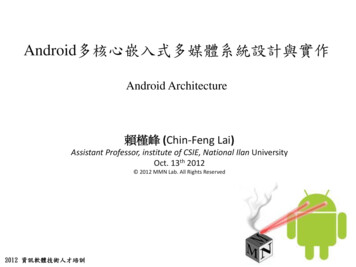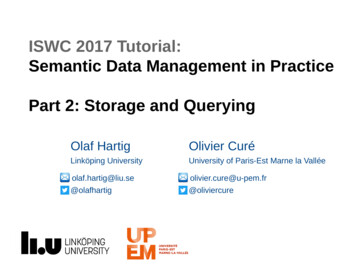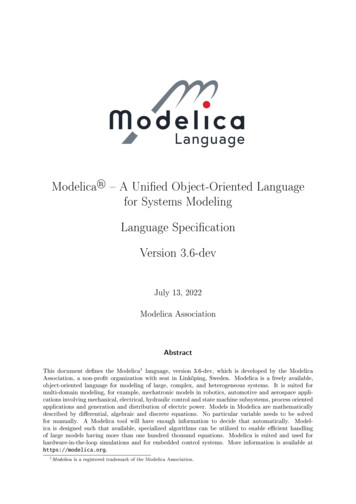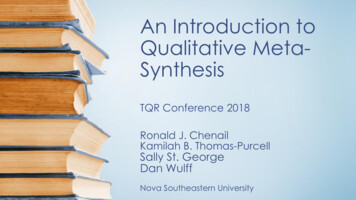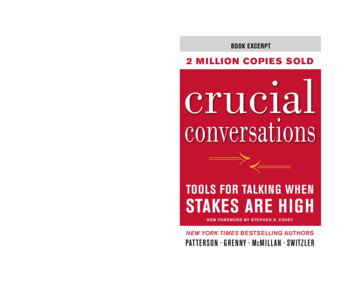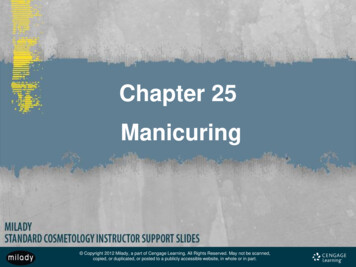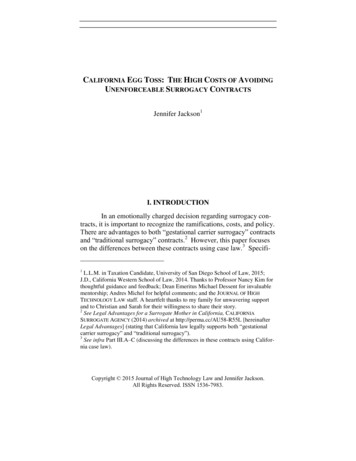
Transcription
CALIFORNIA EGG TOSS: THE HIGH COSTS OF AVOIDINGUNENFORCEABLE SURROGACY CONTRACTSJennifer Jackson1I. INTRODUCTIONIn an emotionally charged decision regarding surrogacy contracts, it is important to recognize the ramifications, costs, and policy.There are advantages to both “gestational carrier surrogacy” contractsand “traditional surrogacy” contracts.2 However, this paper focuseson the differences between these contracts using case law.3 Specifi-1L.L.M. in Taxation Candidate, University of San Diego School of Law, 2015;J.D., California Western School of Law, 2014. Thanks to Professor Nancy Kim forthoughtful guidance and feedback; Dean Emeritus Michael Dessent for invaluablementorship; Andres Michel for helpful comments; and the JOURNAL OF HIGHTECHNOLOGY LAW staff. A heartfelt thanks to my family for unwavering supportand to Christian and Sarah for their willingness to share their story.2See Legal Advantages for a Surrogate Mother in California, CALIFORNIASURROGATE AGENCY (2014) archived at http://perma.cc/AU58-R55L [hereinafterLegal Advantages] (stating that California law legally supports both “gestationalcarrier surrogacy” and “traditional surrogacy”).3See infra Part III.A–C (discussing the differences in these contracts using California case law).Copyright 2015 Journal of High Technology Law and Jennifer Jackson.All Rights Reserved. ISSN 1536-7983.
2015]CALIFORNIA EGG TOSS231cally, this paper will focus on the implications of California case lawregarding surrogacy contracts.4 Cases such as Johnson v. Calvert5and In re Marriage of Moschetta6 provide a clear distinction betweenthese contracts.7 This distinction will show that while gestationalcarrier surrogacy contracts are more expensive, public policy andcourt opinions will provide certainty and peace of mind to intendedparents.8After multiple miscarriages, Debbe and John looked intoadoption as an alternative to starting a family.9 The couple met manyobstacles in the adoption process.10 Debbe researched alternativeswhen she discovered traditional surrogacy.11 The couple realized thiswas a viable option and quickly found a willing surrogate, Valerie.12Valerie contracted with the couple to deliver a child biologically related to herself and John through artificial insemination.13 Valeriewould consent to relinquish her parental rights and Debbe wouldadopt the child after her birth.14 Valerie gave birth to John andDebbe’s baby girl on August 23, 2004.154See infra Part III.A–C (examining issues in surrogacy contracts in California caselaw).5See Johnson v. Calvert, 851 P.2d 776 (Cal. 1993) (focusing on the issues surrounding gestational surrogacy contracts).6See In re Marriage of Moschetta, 30 Cal. Rptr. 2d 893 (Cal. Ct. App. 1994) (analyzing contract issues that arise in traditional surrogacy contracts).7See infra Part III.A–B (comparing the different surrogacy contracts).8See infra Part IV.A–C (exploring the benefits and detriments of the two differentsurrogacy options).9See Debbe, Why We Turned to Traditional Surrogacy One Mother’s Story, ALLABOUT SURROGACY (2004), archived at http://perma.cc/YV5Q-R9M7 [hereinafterDebbe] (sharing alternative means to starting a family when conception is impossible).10See id. (explaining the rigor and the intense scrutiny that is part of the adoptionprocess).11See id. (noting the personal, physical and emotional reasons that surrogacy wasDebbe’s preferred method for starting a family).12See id. (stating that finding a surrogate took less than a month).13See id. (recounting the close relationship between, John and their surrogate, Valerie).14See id. (relating Debbe’s belief that carrying and then giving up one’s baby mustbe difficult).15See Debbe, supra note 9 (reporting no issues for surrogacy whereas with adoption Debbe and John kept hitting “road blocks”).
232JOURNAL OF HIGH TECHNOLOGY LAW[Vol. XV: No.: 2Married couple, Christian and Sarah intended to have childrenone day, when the time was right.16 This made Sarah’s diagnosis ofcervical cancer even more devastating.17 In preparation of chemotherapy, doctors harvested Sarah’s eggs to be frozen for future use(“cryopreservation”).18 Sarah would never be able to carry a child inher womb, but the couple hoped with advancing medical technologythey could still have children, biologically related to them both,through the use of a surrogate.19 If the medical procedure worked, asurrogate would carry a child created by Sarah’s eggs and Christian’ssperm.20Typically there are two types of surrogacy arrangements.21The first is known as “gestational carrier surrogacy” where a womanprovides her womb and carries a child, biologically unrelated to her,to full-term.22 The egg and sperm are provided by the parents whointends to raise the child (“intended parents”).23 The egg and spermmay be the genetic material of the intended parents or the genetic material of donors.24 The second type of surrogacy arrangement is “traditional surrogacy” where the woman who carries the child to term isalso biologically related to the child because it is a result of her eggand either the intended father’s sperm or donated sperm acquired bythe intended parents.2516See Interview with Christian Smith, Father, in San Diego, Cal. (Oct. 30, 2012)[hereinafter Interview with Smith] (names have been changed at the request of theinterviewee to protect the identity of the parties).17See id.18See id.19See id.20See id.21See Brandie Umar, Types of Surrogacy Arrangements, FIND SURROGATEMOTHER (2012), archived at http://perma.cc/5EBA-NNBP (describing the varioustypes of surrogacy).22See CHARLES P. KINDREGAN, JR. & MAUREEN MCBRIEN, ASSISTEDREPRODUCTIVE TECHNOLOGY: A LAWYER’S GUIDE TO EMERGING LAW ANDSCIENCE 105-06 (2d ed. 2011) (explaining gestational carrier surrogacy and theprocess of fertilizing the intended mother’s egg).23See id. (defining the term “intended parents”).24See id. (clarifying that the egg and sperm of the intended parents does not necessarily need to be biologically theirs).25See id. at 151 (addressing the elements of a traditional surrogacy in the context ofmodern assisted reproductive technology).
2015]CALIFORNIA EGG TOSS233Under California law, gestational carrier surrogacy contractsare enforceable;26 whereas, traditional surrogacy contracts are not enforceable.27 Therefore, intended parents tend to avoid traditional surrogacy contracts and instead opt for gestational carrier surrogacy contracts.28 Gestational carrier surrogacy costs additional money sinceintended parents must acquire genetic material or transfer their owngenetic material to the surrogate through expensive medical procedures.29 Thus, enforceable surrogacy contracts are limited to wealthier intended parents, meaning intended parents of more modest meansare not able to secure an enforceable contract for the birth of achild.30Part I of this Article introduces the stories of two familieswith personal surrogacy experiences. Part II of this Article discussesthe two types of surrogacy arrangements and introduces the relationship between surrogacy arrangements and contracts. Part III discusses California’s approach to both traditional and gestational carriersurrogacy contracts. Part IV discusses the ramifications, costs andpolicy behind surrogacy contracts. Part V concludes the Article andargues that enforceable surrogacy contracts are more expensive, butthe practicality of entering an enforceable contract provides assuranceto intended parents that they will raise their child as a result.II. GESTATIONAL CARRIER SURROGACY V.TRADITIONAL SURROGACYA. TerminologyAccording to Concise Medical Dictionary, a surrogate motheris, “a woman who becomes pregnant (by artificial insemination or26See Johnson, 851 P.2d at 782 (confirming that gestational carrier surrogacy contracts are enforceable under California law).27See In re Marriage of Moschetta, 30 Cal. Rptr. 2d at 894-95 (holding that a traditional surrogacy contract by itself is unenforceable).28See KINDREGAN & MCBRIEN, supra note 22, at 341 (discussing newer surrogacyarrangements have replaced traditional contract surrogacy arrangements).29See KINDREGAN & MCBRIEN, supra note 22, at 341-43 (considering additionalexpenses attached to gestational carrier surrogacy due to differences in medicalprocedures).30See KINDREGAN & MCBRIEN, supra note 22, at 341-43 (noting high costs of surrogacy contacts).
234JOURNAL OF HIGH TECHNOLOGY LAW[Vol. XV: No.: 2embryo insertion) following an arrangement made with another party(usually a couple unable themselves to have children) in which sheagrees to give the child she carries to that party when it is born.”31Debbe and John utilized the services of a traditional surrogate mother, Valerie, who carried her biological child to term and subsequentlyconsented to Debbe’s adoption of the baby girl.32 Christian and Sarah utilized the services of a gestational carrier surrogate mother,Amy, who carried the children not biologically related to her to termfor the couple.33A Lawyer’s Guide to Emerging Law and Science defines anintended parent as “an ‘individual, married or unmarried, who manifests the intent as provided in [the ABA Model Act § 102-19] to belegally bound as the parent of a child resulting from assisted or collaborative reproduction.’”34 John and Debbe were the intended parents of their baby girl.35 Christian and Sarah were the intended parents of their twin daughters.36In traditional surrogacy, artificial insemination is a commonprocedure.37 According to Concise Medical Dictionary artificial insemination is the “instrumental introduction of semen into the vaginain order that a woman may conceive.”38 Debbe and John’s surrogate,Valerie, underwent artificial insemination, using John’s sperm, forthe conception of their baby girl.39In vitro fertilization is commonly used in gestational carriersurrogacy.40 Concise Medical Dictionary explains in vitro fertilization as the “fertilization of an ovum [(“egg”)] outside the body, the31Surrogate Mother, CONCISE MEDICAL DICTIONARY (8th ed. 2014).See Debbe, supra note 9 (inferring the surrogate’s consent from the fact that shegave the baby to Debbe and John without issue).33See Interview with Smith, supra note 16.34KINDREGAN & MCBRIEN, supra note 22, at 2 n. 5.35See Debbe, supra note 9 (highlighting that all the parties agreed that the childwas Debbe and John’s).36See Interview with Smith, supra note 16.37See KINDREGAN & MCBRIEN, supra note 22, at 153 (noting an increase in artificial insemination in traditional surrogacy).38Artificial Insemination, CONCISE MEDICAL DICTIONARY (8th ed. 2014).39See Debbe, supra note 9 (describing the traditional surrogacy process that usesthe surrogate’s egg).40See KINDREGAN & MCBRIEN, supra note 22, at 153 (noting the increase of invitro fertilization).32
2015]CALIFORNIA EGG TOSS235resultant zygote being incubated to the blastocyst stage and then implanted in the uterus.”41 Christian and Sarah’s surrogate, Amy, underwent an in vitro fertilization procedure to place the resulting blastocysts in Amy’s uterus.42B. Purpose of Contracts in Surrogacy ArrangementsThe common purpose of a contract is to enforce promises.43In The Divergence of Contract and Promise, Professor Seanna Valenitne Shiffrin stated, “[p]romises and their availability provide a concrete (and I believe indispensable) way for parties to reaffirm theirequal moral status and respect for each other under conditions inwhich possibly divergent present or future interests create vulnerability.”44 There may be no greater vulnerability than intended parents’interest in their unborn child carried to term by a woman who promises to perform as a surrogate mother, in either a traditional or gestational carrier situation.45In a traditional surrogacy setting, the intended father provideshis sperm or donor sperm for an artificial insemination procedure tocreate a child with a woman who promises to birth the child for thepurpose of allowing the intended parents to raise the child.46Debbe and John entered into a traditional surrogacy contractwith Valerie.47 The result was a child Debbe and John raise as a41In Vitro Fertilization, CONCISE MEDICAL DICTIONARY (8th ed. 2014), archivedat http://perma.cc/K3KN-FYE7 (defining in vitro fertilization).42See Interview with Smith, supra note 16.43See Morris R. Cohen, The Basis of Contract, 46 HARV. L. REV. 553, 571 (1933)(stating that the common purpose of contract law is supposed to be the enforcementof promises).44Seana Valentine Shiffrin, The Divergence of Contract and Promise, 120 HARV.L. REV. 708, 750 (2007).45See Joseph Chamie & Barry Mirkin, Surrogacy: Human Right or ReproductiveExploitation, YALEGLOBAL ONLINE (Oct. 28, 2014), archived athttp://perma.cc/4R7E-QLLC (describing issues that can leave intended parents vulnerable even when there are legal agreements involved).46See KINDREGAN & MCBRIEN, supra note 22, at 152 (defining traditional surrogacy).47Cf. Debbe, supra note 9 (describing the evolution of the relationship and theagreement made between the parties).
236JOURNAL OF HIGH TECHNOLOGY LAW[Vol. XV: No.: 2member of their family.48 Valerie kept her promise to consent toDebbe’s adoption of the baby and did not breach the contract.49However, Valerie’s position of power left Debbe and John vulnerableto her promise to consent to Debbe’s adoption the child, after itsbirth.50Since traditional surrogacy contracts are not enforceable inCalifornia it is the final decision of the surrogate whether the partieswill receive their expectations.51 When the surrogate breaches theunenforceable contract the family court is left to decide what is in the“best interests” of the child for custody.52 This could end in a jointcustody arrangement between the biological father and mother.53Thus, if Valerie had changed her mind, John and Valerie would sharecustody of the child and Debbe would be a stepmother. The vulnerability of the intended parents is apparent in a traditional surrogacysetting.In a gestational carrier surrogacy, the intended parents provide a zygote, which forms into a blastocyst, through their own eggand sperm, donated egg and sperm, or a combination of the two.54The surrogate mother undergoes an in vitro fertilization procedureand promises to carry the child to term for the intended parents.5548See Debbe, supra note 9 (showing a traditional surrogacy arrangement).See Debbe, supra note 9 (providing details of Debbe’s experiences after returning home with the child).50See Chamie, supra note 45 (mentioning the potential legal vulnerabilities that intended parents face as a result of a surrogacy arrangement); cf. Debbe, supra note 9(noting that Debbe’s name was left off the birth certificate as required court documents had not yet been received by the hospital).51See In re Marriage of Moschetta, 30 Cal.Rptr. 2d at 902-03 (concluding that California courts refuse to enforce traditional surrogacy contracts if the surrogatemother decides to keep her biological child).52See Johnson, 851 P. 2d at 799 (asserting the courts responsibility to uphold thefrequently applied standard of the “best interests” of the child).53See, e.g., In re Marriage of Moschetta, 30 Cal.Rptr. 2d at 901 (addressing the trial court’s holding awarding joint custody between father and biological mother later overturned).54See Kindregan & McBrien, supra note 22, at 105-06 (explaining the processes bywhich gestational carrier surrogacy can occur).55See, e.g., Johnson, 851 P. 2d at 778 (describing the gestational surrogacy arrangement between the genetic parents and surrogate mother).49
2015]CALIFORNIA EGG TOSS237After Sarah’s cancer remission, Christian and Sarah decidedthey were ready to start a family.56 In 2002 they made their first attempt at pregnancy through the services of a surrogate.57 After finding a willing surrogate, they had a medical facility combine Sarah’segg with Christian’s sperm outside the surrogate’s body.58 On thatattempt, none of the resulting zygotes developed into healthy blastocysts for implantation in the surrogate’s uterus.59 Sarah’s eggs weregone.60 The chance for a child biologically related to both Sarah andChristian was over.61 They put their family plans on hold.62In 2007, Christian and Sarah discussed the possibility of trying for a family again.63 Advancing medical technology allowed intended parents to acquire donor eggs for use in substitute for Sarah’seggs.64 Amy, a mutual friend they knew, desired to be a gestationalcarrier surrogate.65 They decided to locate an anonymous egg donorthrough an agency and use Christian’s sperm.66 The medical facilityrepeated the process of combining Christian’s sperm with eggs, thistime acquired from an egg donor rather than using Sarah’s eggs.67Two of the zygotes developed into healthy blastocysts proper for implantation into Amy’s uterus.68 Nine months later Amy gave birth toChristian and Sarah’s fraternal (non-identical) twin daughters.69This gestational carrier surrogacy contract was enforceable inthe state of California.70 Amy was not required to give consent foradoption since the twins were not biologically related to her, plus56See Interview with Christian Smith, supra note 16.See Interview with Christian Smith, supra note 16.58See Interview with Christian Smith, supra note 16.59See Interview with Christian Smith, supra note 16.60See Interview with Christian Smith, supra note 16.61See Interview with Christian Smith, supra note 16.62See Interview with Christian Smith, supra note 16.63See Interview with Christian Smith, supra note 16.64See Interview with Christian Smith, supra note 16.65See Interview with Christian Smith, supra note 16.66See Interview with Christian Smith, supra note 16.67See Interview with Christian Smith, supra note 16.68See Interview with Christian Smith, supra note 16.69See Interview with Christian Smith, supra note 16.70See Johnson, 851 P.2d at 778 (holding that the gestational surrogacy contract wasvalid and enforceable in California).57
238JOURNAL OF HIGH TECHNOLOGY LAW[Vol. XV: No.: 2Christian and Sarah were the intended parents.71 Christian and Sarah’s position was less vulnerable because of the enforceability of thecontract.72Christian and Sarah could have asked Amy to donate her eggsfor the process, but this would have been a traditional surrogacy arrangement.73 The couple was assured they would raise their daughters and avoid potential litigation with Amy because they took a twostep process.74 First they acquired donated eggs and found a separatesurrogate willing to carry their babies.75 Fortunately, Christian, Sarahand their twins continue a special relationship with Amy to this day.76Amy never questioned her role in the lives of these baby girls.77Either circumstance leaves the intended parents in a vulnerable position until the child is born and placed with the intended parents.78 The promise to perform by each party is critical.79 If thesepromises are enforceable by the courts because the parties enter acontract, the vulnerabilities are protected interests.80 Because gestational carrier surrogacy contracts are enforceable, parties to such contracts are able to protect their interests.81 The unenforceable tradi-71See id. (describing that a gestational surrogate is not required to give adoptiveconsent because the child is not biologically hers).72See id. (establishing that gestational surrogacy arrangements offer more protection for the intended parents because they are enforceable contracts).73See In re Marriage of Moschetta, 30 Cal. Rptr. 2d at 895 (illustrating how a traditional surrogacy agreement is formed).74See Interview with Christian Smith, supra note 16.75See Interview with Christian Smith, supra note 16.76See Interview with Christian Smith, supra note 16.77See Interview with Christian Smith, supra note 16.78See Johnson, 851 P.2d at 778 (describing a situation in which the intended parents, after a legal battle, got custody of the biologically related child).79See In re Marriage of Moschetta, 30 Cal. Rptr. 2d at 894 (stating an example of asuccessful surrogate agreement where the biologically related parents receive thechild).80See Johnson, 851 P.2d at 778 (showing in this case that the court upheld the surrogate contract, allowing the biologically related parents to keep the baby).81See id. (holding that the interests to the biological parents are protected underCalifornia law).
2015]CALIFORNIA EGG TOSS239tional surrogacy contract leaves intended parents vulnerable to thesurrogate mother’s final decision, after the child’s birth.82C. Issues Related to Enforcement of Surrogacy Contractsi. Private AutonomyThe will theory of contracts emphasizes a required “meetingof the minds” of the parties at the time of contract formation.83 Thecourt must look at the subjective intent of the parties.84 However, itis difficult to subjectively understand what someone else is thinkingor to set a standard for the courts to look to when determining this requirement.85 In surrogacy contracts, formation takes place at multiple times dependent on the type of surrogacy.86Formation in a traditional surrogacy contract takes place before the artificial insemination procedure; however, the surrogatemust consent to the adoption after the child is born.87 The adoptionrequires a separate contract and therefore, the will of the parties mustbe looked at a second time.88 The surrogacy agreement merely establishes a present intent to consent for the future adoption following thechild’s birth.89 However, if a surrogate refuses to consent to the82See In re Marriage of Moschetta, 30 Cal. Rptr. 2d at 901 (implying that if thesurrogacy contract is not enforceable, parents of surrogate children will have norights to the child born if the surrogate decides to keep them).83See Cohen, supra note 43, at 575 (discussing the implications of contract law in asurrogacy agreement, requiring a “meeting of the minds” from both parties).84See JOHN EDWARD MURRAY, JR., MURRAY ON CONTRACTS § 30 (4th ed. 2001)(asserting that mutual assent is necessary when creating a surrogacy contract).85See id. (noting that courts lack clear standards to apply when determining whether the contracting parties shared the same intent).86See id. (describing the initial stage of entering into a contract, known as formation).87See CAL. FAM. CODE § 8814 (West 2014) (examining the consent process wherea surrogate and biological parents must agree to before, during and after the child’sbirth); see also In re Marriage of Moschetta, 30 Cal. Rptr. 2d at 900 (holding thatthe birth mother must consent to the adoption after the surrogate child is born).88See In re Marriage of Moschetta, 30 Cal. Rptr. 2d at 900 (inferring that the traditional surrogacy contract is not sufficient enough to establish an adoption agreement).89See CAL. FAM. CODE § 8814 (West 2014) (highlighting the procedures for surrogacy which includes signing an agreement in the presence of a social worker); see
240JOURNAL OF HIGH TECHNOLOGY LAW[Vol. XV: No.: 2adoption, the meeting of the minds has not occurred.90 Since theoriginal contract is not enforceable, the courts only look to the surrogate’s intent to consent to the adoption.91A surrogate mother might intend to consent to the adoption ofher child at the time she signs the surrogacy agreement.92 However,it is human nature for a mother to experience a connection with herchild during the pregnancy and at birth.93 Therefore, her changed intent at the time of the second contract, the adoption agreement, isforeseeable by a reasonable person.94 The court will not force a parent to consent to the adoption of their child.95If Valerie did not consent to relinquish her parental rights toher baby girl to Debbe and John, the court would not enforce the surrogacy contract.96 The court would not look to the meeting of thealso In re Marriage of Moschetta, 30 Cal. Rptr. 2d at 903 (stating that a surrogacycontract cannot serve as an adoption agreement).90See Nicholas C. Dranias, Consideration as Contract: A Secular Natural Law ofContracts, 12 TEX. REV. L. & POL. 267, 281 (2008) (defining “meeting of theminds” as a requirement in establishing a valid contract).91See In re Marriage of Moschetta, 30 Cal. Rptr. 2d at 901 (establishing that thesurrogacy contract does not serve as a binding agreement to give the child up foradoption).92See Lori B. Andrews, Beyond Doctrinal Boundaries: A Legal Framework forSurrogate Motherhood, 81 VA. L. REV. 2343, 2351 (1995) (suggesting surrogatemothers do not anticipate psychological consequences of pregnancy).93See id.(highlighting the factors that might influence a surrogate’s desire to keepthe child); see also The Unborn Child – Connected to the Mother by Feelings andExperiences, PRENATAL PARENTING INFORMATION, archived athttp://perma.cc/D4PQ-3J97 (inferring that a mother develops a relationship andfeelings towards her unborn child during pregnancy).94See Andrews, supra note 92, at 2351 (highlighting the emotional change in themother as evidenced by her wanting to keep the child).95See CAL. FAM. CODE § 8814 (2004) (establishing consent is required and adoption will not be forced); In re Marriage of Moschetta, 30 Cal. Rptr. 2, at 901 (outlining the policy that the court will not force a surrogate mother to consent to anadoption in traditional surrogacy, as opposed to gestational carrier surrogacy).96See Debbe, supra note 9 (providing background of Debbe’s surrogacy experience); see also In re Marriage of Moschetta, 30 Cal. Rptr. 2d at 901 (reiteratingthat the courts will not force a traditional surrogate mother into relinquishing parental rights through).
2015]CALIFORNIA EGG TOSS241minds at the formation of the surrogacy contract.97 The analysiswould strictly look to the intent of the parties at the time of adoption.98In gestational carrier surrogacy, the contract formation takesplace prior to in vitro fertilization.99 This type of surrogacy does notrequire a subsequent adoption agreement because the surrogate is notbiologically related to the child.100 The meeting of the minds musttake place at the time the surrogacy contract is formed.101 The courtslook to the contract to determine the intent.102 Parties enter thesecontracts voluntarily without the concerns of adoption addressed intraditional surrogacy.103 Therefore, the meeting of the minds, as necessary according to the will theory of contracts, is satisfied.104If Amy failed to provide the children to Christian and Sarah,the courts would look to the surrogacy contract because a gestationalcarrier surrogacy arrangement is enforceable.105 The meeting of the97See In re Marriage of Moschetta, 30 Cal. Rptr. 2d at 900 (upholding the decisionto look to the intent of the parties at the time of adoption rather than at the point ofsigning the traditional surrogacy agreement).98See id. at 901 (explaining that the court will look to the intent of the parties afterthe pregnancy when enforcing a surrogacy contract).99See Johnson, 851 P.2d at 777 (inferring that in the case of gestational surrogacy,a contract made prior to pregnancy is enforceable).100See id. at 784 (clarifying that gestational carrier surrogacy compensates the surrogate for carrying the child and does not imply any parental rights); In re Marriage of Moschetta, 30 Cal. Rptr. 2d. at 903(affirming the court’s holding in Johnson v. Calvert that surrogacy via embryo implantation results in no parental rightsof the surrogate mother).101See Johnson, 851 P.2d at 783 (announcing intent of the parties is determined atthe time the surrogacy contract is established).102See id. at 783 (recognizing the surrogacy contract as the only source to determine intent).103See In re Marriage of Moschetta, 25 Cal. App. at 1235 (concluding that gestational carrier surrogacy contracts present less legal problems because of the lack ofparental rights afforded to the surrogate mother because she lacks any relation tothe baby).104See Cohen, supra note 43, at 575 (highlighting that “meeting of the minds” isthe first essential element in the will theory of contracts).105See Legal Advantages, supra note 2 (noting that California courts have consistently upheld gestational surrogacy contracts); cf. Johnson, 851 P.2d at 783 (recognizing that, in deciding maternity, a surrogacy contract is not inconsistent with public policy).
242JOURNAL OF HIGH TECHNOLOGY LAW[Vol. XV: No.: 2minds occurred at the contract formation, prior to the implantation ofChristian and Sarah’s blastocysts.106 Since Amy, Christian and Saraheach intended to create Christian and Sarah’s children for the purposeof Christian and Sarah to raise them, the court would easily declareChristian and Sarah the twin’s parents.107ii. RelianceThe traditional contract doctrine elements of offer, acceptanceand consideration are easily identified in surrogacy contracts; however, the concern is whether or not the consideration is valid.108California law prohibits payment in exchange for the adoptionof a child.109 Traditional surrogacy contracts violate this law becausethe bargained-for-exchange includes the subsequent consent by thesurrogate to relinquish her parental rights.110 Therefore, the courtconsiders the compensation paid to the surrogate, in part, for relinquishing her parental rights.111The compensation to Valerie was, in part, to compensate herfor the consent to allow Debbe to adopt her child.112 This is prohibited by law.113 Had Valerie changed her mind, the surrogacy agreement would not be enforceable.114 The court would declare Valerie106See Interview with Smith, supra note 16.See Johnson, 851 P.2d at 796 (Kennard, J., dissenting) (concluding that thewoman who brings about “the birth of a child that she intended to raise as her own”is the natural mother under California law).108See id. (Kennard, J., dissenting) (arguing “rights in children cannot be sold forconsideration”).109See CAL. PENAL CODE § 273 (2014) (classifying an offer to pay, receive moneyor other consideration for an adoption, as a
2015] CALIFORNIA EGG TOSS 231 cally, this paper will focus on the implications of California case law regarding surrogacy contracts.4 Cases such as Johnson v.Calvert5 and In re Marriage of Moschetta6 provide a clear distinction between these contracts.7 This distinction will show that while gestational carrier surrogacy contracts are more expensive, public policy and
